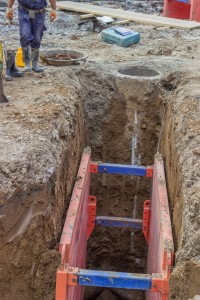 Construction sites are a big emphasis for the Occupational Health and Safety Administration (OSHA). According to their website, construction is among the most dangerous industries in the country and construction inspections comprise 60% of OSHA’s total inspections.
Construction sites are a big emphasis for the Occupational Health and Safety Administration (OSHA). According to their website, construction is among the most dangerous industries in the country and construction inspections comprise 60% of OSHA’s total inspections.
The four leading causes of construction industry fatalities are called the OSHA Focus Four. This includes the following hazards:
- Struck By
- Electrocution
- Caught-in-Between
- Fall
This final installment in our blog series will help identify “Caught in or in-between” hazards and how to keep your crew safe and free from injury on the jobsite.
Caught in or in-between hazards can cause injury or death in a variety of ways, including: cave-ins, being pulled into an unguarded piece of machinery, or being compressed between to moving objects or a moving and stationary object.
Excavations/Trenching Cave-ins
These particular types of hazards are common on most construction sites. These workers are more than twice as likely to be killed as workers in any other type of construction. Cave-ins happen when the soil walls are unstable. Vibration from heavy, moving machinery or traffic could potentially cause a cave-in. Too much weight next to the sides of your excavation, using water or changes in weather could also affect the stability of your project. Cave-ins are particularly dangerous in nature because the weight of the soil could crush or suffocate your employee.
What can you do to protect your employees from a cave-in? Sloping or benching your excavation walls for trenches deeper than 5 feet, but less than 20 will help stabilize the soil walls. Trench boxes may not prevent a cave-in, but they can protect the worker should a cave-in occur. Shoring could also help keep the earth in place as a support. Ladders, stairways or ramps are required in any trench four feet or deeper.
Unguarded Machinery
Workers can easily get a limb caught in a piece of machinery. Loose clothing can easily get pulled into an unguarded piece. Make sure machines are ALWAYS properly guarded. Also employees should follow a lock-out process while equipment is being serviced or repaired to prevent any injury. Training your team to properly identify areas of concern or hazards and how to avoid unsafe conditions will help keep your employees safe from getting caught in machinery or equipment.
Between Objects
Injuries and fatalities can occur when getting caught in between a vehicle such as a trailer or heavy equipment and a stationary object just as a loading dock. Barricades should be used to keep employees out of the swing radius of a piece of equipment, also making sure all members of your crew are alert when working on site with moving equipment – not only the drivers. Make sure when working on different pieces of equipment each piece is safely locked; lower or block blades of bulldozers or scrapers when making repairs will help keep your employees safe from being crushed should something slip or fall.
Aerial Lifts
In some instances, fatalities have occurred when workers are in the basket of an aerial lift and get crushed against objects. Imagine if working near roof joists, rafters, steel structures, or against a wall and the equipment suddenly lunges. Even more dangerous is a case where a basket lunges and the worker becomes pinned against the control center of the lift basket. This prevents spotters on the ground from manually lowering the basket. To stay safe in aerial lifts, constantly review conditions surrounding yourself such as wind, grade, and obstructions. A spotter is also very helpful in preventing these types of accidents. Lastly, when the basket is stationary during a work operation, the piece of equipment should be turned off. Many times, the engine is left running as workers often need to move it to reach their work. However, this increases the exposure to accidents and wastes fuel.
The key to keeping your work crews safe, regardless of the situation is education. Again, making sure your team is properly trained to identify possible hazards and to have the know-how to remove or remedy the issue, will keep your team safe.
To learn more about Trisco Systems call 419-339-3906 or email office@triscosystems.com.

